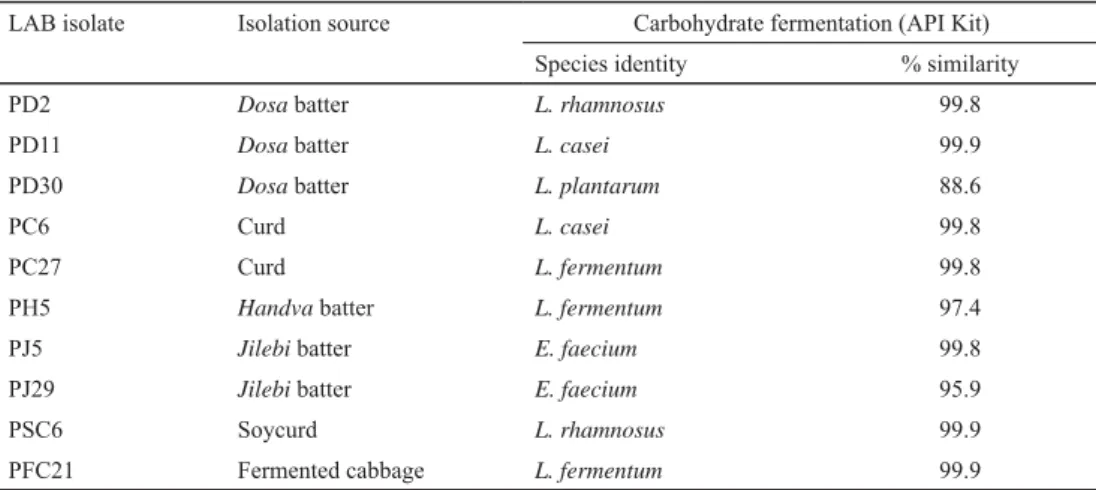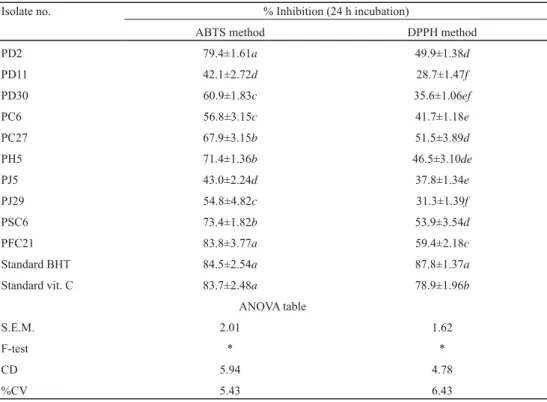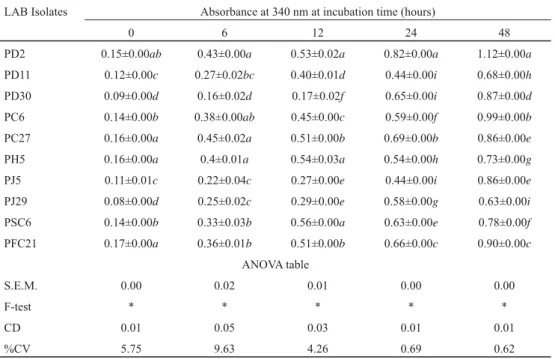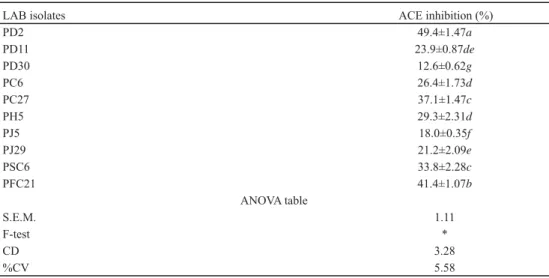0139–3006 © 2018 Akadémiai Kiadó, Budapest DOI: 10.1556/066.2018.47.1.14
EVALUATION OF ANTIOXIDATIVE, PROTEOLYTIC, AND ACE INHIBITORY ACTIVITIES OF POTENTIAL PROBIOTIC LACTIC ACID
BACTERIA ISOLATED FROM TRADITIONAL FERMENTED FOOD PRODUCTS
P.N. THAKKARa,c, A.R. PATELb*, H.A. MODIa and J.B. PRAJAPATIc aDepartment of Life Sciences, Gujarat University, Ahmedabad. India
bDivision of Dairy and Food Microbiology, Mansinhbhai Institute of Dairy & Food Technology-MIDFT, Mehsana.
India
cDepartment of Dairy Microbiology, SMC College of Dairy Science, Anand Agriculture University, Anand. India (Received: 20 June 2017; accepted: 23 August 2017)
Probiotic lactic acid bacteria (LAB) have been engrossed in plentiful food fermentations, known to man for millennia. The current investigation was aimed at investigating technical attributes, such as production of bioactive peptides, particularly ACE-I activity (anti-hypertensive property), proteolytic activity, and antioxidant activities of the potential probiotic LAB strains isolated from a diverse dairy and non-dairy based fermented foods. Among all ten LAB isolates, PFC21, isolated from sauerkraut, exhibited the highest antioxidative potential and showed maximum free radical scavenging ability using both ABTS (83.8±3.77%) and DPPH (59.4±2.18%) assays. It was followed by PD2 (dosa batter isolate) that showed (79.4±1.61%) activity in ABTS assay. PD2 revealed the highest proteolytic activity during 24 h and 48 h (with 0.82 and 1.12 absorbance, respectively) of fermentation at 37 °C;
followed by a curd isolate, PC6, and PFC21 with 0.99 and 0.90 absorbance, respectively, at 48 h incubation.
Furthermore, PD2 also showed the signifi cantly (P<0.05) highest (49.39%) ACE inhibition followed by PFC21 (41.38%). These fascinating results led us to further evaluate the potential probiotic strains with regard to their utilization in the production of healthy quality foods with additional technical advantages.
Keywords: probiotics, antioxidative potential, bioactive peptide, angiotensin-converting-enzyme (ACE) inhibition
The growing attention to understand the role of food in human health has budged it from its primary role as a source of energy to the subtle action of biologically dynamic food components for wellbeing. Henceforth, there is a growing demand for functional foods at present. In India, variety of dairy and non-dairy fermented foods are known and consumed by large population as a part of their daily diet, but their probiotic role had not been investigated widely. Incorporation of probiotic microorganisms isolated from various regional fermented food products in market can positively enhance health status of larger segment of communities.
Reactive oxygen species (ROS) mediated oxidative damage of vital cell components is known to play crucial role in the development of chronic diseases such as diabetes mellitus, cancer, heart disease, Alzheimer, cataract, and aging (MISHRA et al., 2015). It occurs as a result of imbalance between the generation of oxygen derived radicals and the antioxidant potential of the organism. Bioactive peptides produced from LAB through enzymatic hydrolysis and/or microbial proteolysis during milk fermentation are known to possess
* To whom correspondence should be addressed.
Phone: +91–2762243777; fax: +91–02762–253422; e-mail: amiamipatel@yahoo.co.in
114
oxidative inhibitory capacity due to their ability to scavenge free radicals (VIRTANEN et al., 2007). Strains of LAB may reinforce the inherent cellular antioxidant defence by secretion of enzymes like superoxide dismutase (SOD) or promote production of the major non-enzymatic antioxidant and free radical scavenger glutathione (GSH). Currently, synthetic antioxidants like butylated hydroxyanisole (BHA) and butylated hydroxytoluene (BHT) have limited use because of their suspected carcinogenic potential and thus, there is a shift towards the use of natural antioxidants (CHTOUROU et al., 2011). Recent studies suggest that probiotics may have a potential therapeutic role in ROS characterized gastrointestinal disorders (SPYROPOULOS et al., 2011).
Proteolysis is the most important biochemical process that occurs in cultured milk products during fermentation and storage; resulting in the release of bioactive peptides from specifi c amino acid sequences within the parent milk proteins that can provide physiological benefi ts (YOSHIKAWA et al., 2000). During fermentation, milk proteins get hydrolysed by LAB proteinases and peptidases resulting in an enhanced quantity of free amino groups and various forms of peptides (KHOLIF et al., 2011). Generally, the extent of proteolysis varies among strains and is time as well as strain dependent (DONKOR et al., 2007).
Fermented milks are excellent sources of bioactive peptides owning specifi c physiological roles like antibacterial, anticancer, and antihypertensive activities. Among these, the antihypertensive peptides or Angiotensin converting enzyme inhibitors (ACE-I) are the most broadly studied. ACE inhibitory peptides have been isolated from a variety of fermented dairy products including cheeses, fermented milks, and yoghurts (FITZGERALD &
MEISEL, 2000), and these bioactive peptides could serve as healthier and natural alternatives of ACE-I drugs (DONKOR et al., 2007).
Strains of LAB used in current study have shown potential probiotic candidature in earlier investigations (THAKKAR et al., 2015). Hence, in addition to the claimed health benefi ts of probiotics, the present investigation was principally aimed to determine the technical attributes of these potential probiotic LAB isolates, including production of bioactive peptides, particularly ACE-I activity, proteolytic activity, and antioxidant activities.
1. Materials and methods
1.1. Source of cultures
Total 10 test strains of LAB, i.e. PD2, PD11, PD30 (Dosa batter); PC6, PC27 (Curd); PH5 (Handva batter); PJ5, PJ29 (Jilebi batter); PSC6 (Soycurd); and PFC21 (Fermented cabbage) were transferred to MRS broth for propagation prior to experiments. The stock cultures were prepared in glycerol (80%) and preserved in –20 ºC. All microbiological media and chemicals were procured from HiMedia (Mumbai, India). These isolates were subjected to species level biochemical identifi cation based on their carbohydrate fermentation profi le using API test stripes (Table 1).
1.2. Antioxidant activity
The antioxidant activity was evaluated by two different assays, ABTS and DPPH, making the use of cell free extract of overnight grown culture. BHT and vitamin C (ascorbic acid) were used as synthetic and natural standards (100 μg ml–1).
Table 1. Details of selected LAB strains
LAB isolate Isolation source Carbohydrate fermentation (API Kit)
Species identity % similarity
PD2 Dosa batter L. rhamnosus 99.8
PD11 Dosa batter L. casei 99.9
PD30 Dosa batter L. plantarum 88.6
PC6 Curd L. casei 99.8
PC27 Curd L. fermentum 99.8
PH5 Handva batter L. fermentum 97.4
PJ5 Jilebi batter E. faecium 99.8
PJ29 Jilebi batter E. faecium 95.9
PSC6 Soycurd L. rhamnosus 99.9
PFC21 Fermented cabbage L. fermentum 99.9
1.2.1. ABTS [2, 29-Azinobis (3-ethylene benzothiazoline) 6-sulphonic acid] assay. In this method, the total radical scavenging capacity is based on ability of a compound to scavenge the stable ABTS radical in 10 min (RE et al., 1999). The ABTS working solution was prepared by mixing 88 μl of 140 mM potassium persulphate with 5 ml of 7 mM ABTS stock solution followed by overnight incubation in dark bottles for generation of radicals.
Then it was diluted with phosphate buffer saline (PBS) to adjust the absorbance at 734 nm to (0.7±0.02). An aliquot of 10 μl of product supernatant, collected after centrifugation at 10 000 g for 30 min, was transferred into 96 wells micro plate and to that 100 μl of ABTS in PBS solution was added and mixed for 10 sec. The decrease in the absorbance at 734 nm was recorded over the period of 10 min at 10 sec interval using Multiplate reader. The free radical scavenging activity (%) was calculated by the following equation; where ‘blank’ means ABTS solution and PBS without sample:
% Scavenging activity = {(A734nm blank – A734 nm sample) / (A734 nm blank)}×100
1.2.2. DPPH [2,2 diphenyl-1-picrylhydrazyl] assay. The antioxidant activity from the extracts of products (fermented milk made from each isolate) was analysed through modifi ed DPPH method (HATI et al., 2013). Hundred μl of the product supernatant from an appropriate dilution, collected after centrifugation at 10 000 g for 30 min, was loaded into 96 wells micro plate, mixed with 100 μl of freshly prepared DPPH solution, and incubated in dark for 120 min at 37 ºC after covering the micro plate with aluminium foil. The absorbance of the solution was measured at 517 nm against methanol using Multiplate reader. The experiment was performed in triplicates and the results were expressed as below; where ‘blank’ means DPPH solution and PBS without sample:
% Scavenging activity = {(A515 nm blank – A515 nm sample)/(A515 nm blank)}×100
1.3. Proteolytic activity
The degree of proteolysis during the fermentation of milk was quantifi ed by measuring free amino (NH2-) groups using o-phthalaldehyde (OPA) method (DONKOR et al., 2005). Three ml curd samples were added to 3 ml of 1% (w/v) trichloroacetic acid (TCA). The suspension was vortexed and vacuum fi ltered using Whatman fi lter paper. One hundred and fi fty microlitres
116
of TCA soluble peptides was added to 3 ml of OPA reagent, and after 2 min of incubation (20±1 °C), the absorbance was measured at 340 nm with using Systronic PC based double beam spectrophotometer (model:2202), India. The experimental procedure was repeated with untreated reconstituted skim milk (RSM) as a control. A relative degree of proteolysis was determined as the difference between the free amino groups in fermented milk and untreated milk with respect to their OD values.
1.4. ACE-inhibitory activity
ACE inhibitory activity was determined according to the technique of CHEUNG (1971) with a little modifi cation (PAPADIMITRIOU et al., 2007). Active cultures were inoculated into a 10%
reconstituted skim milk (at the rate of 2%), incubated for 24 h, and fermented milk was centrifuged at 10 000 g for 10 min at 4 °C (Eppendorf Centrifuge, US). The supernatant was collected and fi ltered through 0.2 μm cellulose acetate membrane fi lter. Thereafter, 50 μl of 5 mM HHL (hippuryl-L-histidyl-L-leucine) (10.74 mg HHL in 5 ml sodium borate buffer, pH 8.3) solution was mixed with 500 μl deionized water and 100 μl of sample (fi ltrate). The reaction was initiated by the addition of 20 μl (4 mU in 250 μl) of ACE enzyme and the mixture was incubated for 30 min at 37 °C. The reaction was terminated by the addition of 1000 μl of 1 M HCl. The hippuric acid liberated by the ACE was extracted with 1.7 ml ethyl acetate and then heated at 100 °C for 20 min in water bath. The residues containing hippuric acid were dissolved in 2 ml of deionized water and the absorbance of the solution was measured spectrophotometrically at 250 nm against blank. The extent of inhibition was calculated as follows.
% ACE Inhibitory activity = {1–C–D)/(A–B)}×100 (%) where,
A: the absorbance of solution containing ACE but no sample
B: the absorbance of solution containing ACE but no sample and HCl C: the absorbance of solution containing ACE, sample and HCl D: the absorbance of solution containing ACE, sample but no HCl
The extent of inhibition is estimated as the concentration of the component that inhibits 50% of ACE activity (IC50) under the given conditions (DONKOR et al., 2007).
1.5. Statistical analysis
The results of three individual experiments were gathered to generate the mean± standard deviation (SD). One-way analysis of variance (ANOVA) was used to determine the signifi cance by using Minitab at P<0.05.
2. Results and discussion
India is a country of rich microbial diversity with an array of food habits. Fermented foods have been a regular part of meal for most Indians and have also been well known for its extended shelf life.
2.1. Antioxidant activity
Total antioxidative potential of ten lactobacilli cultures were determined by ABTS assay and DPPH assay; results were expressed in terms of percentage (%) activity (Table 2). The
scavenging ability of the cell free extracts of the probiotic strains were compared with the standard antioxidants, ascorbic acid (vit. C), and BHT.
Table 2. Antioxidant activity of LAB isolates by ABTS and DPPH methods
Isolate no. % Inhibition (24 h incubation)
ABTS method DPPH method
PD2 79.4±1.61a 49.9±1.38d
PD11 42.1±2.72d 28.7±1.47f
PD30 60.9±1.83c 35.6±1.06ef
PC6 56.8±3.15c 41.7±1.18e
PC27 67.9±3.15b 51.5±3.89d
PH5 71.4±1.36b 46.5±3.10de
PJ5 43.0±2.24d 37.8±1.34e
PJ29 54.8±4.82c 31.3±1.39f
PSC6 73.4±1.82b 53.9±3.54d
PFC21 83.8±3.77a 59.4±2.18c
Standard BHT 84.5±2.54a 87.8±1.37a
Standard vit. C 83.7±2.48a 78.9±1.96b
ANOVA table
S.E.M. 2.01 1.62
F-test * *
CD 5.94 4.78
%CV 5.43 6.43
Values expressed are mean ± S.E.M; a,b,c,d,e,f: values with different superscripts differ signifi cantly (P<0.05) in each rows & columns
Among all ten isolates, PFC21 (sauerkraut isolate) could be considered as the most appropriate for preparing fermented product with high antioxidative property, as it showed maximum free radical scavenging ability using both ABTS (83.8±3.77%) and DPPH (59.4±2.18%) assays followed by standards, vitamin C, and BHT. Similarly, PD2 (dosa batter isolate) displayed 79.4±1.61% scavenging activity with ABTS (non-signifi cant with PFC21 and standards). Three isolates, i.e. PSC6 (53.9±3.54), PC27 (51.5±3.89) and PD2 (49.4±1.38), exhibited similar trend (non-signifi cant to each other) as confi rmed using DPPH free radical assay. All isolates exhibited >25% free radical scavenging activity following both methods;
among all isolates, PFC21, PSC6, PD2, PC27, and PH5 showed very good antioxidant potential as compared to standards.
HATI and co-workers (2013) studied the antioxidative activity of probiotic lactobacilli in soy milk by ABTS method. L. rhamnosus C6 showed maximum antioxidative activity, i.e.
percentage inhibition (97.0%), followed by L. rhamnosus NCDC 19 (92.0%), L. casei NCDC 17 (90.2%), L. rhamnosus C2 (89.1%), L. rhamnosus NCDC 24 (88.6%), and L. casei NCDC 297 (88.0%); besides, L. rhamnosus C6 strain also exhibited 50.2% inhibition using DPPH assay. AFIFY and co-workers (2012) reported scavenging potential of the cell free extracts
118
using ABTS assay; the maximum activity was observed with cell free extract of Probionebacterium freudenreichii (84.7%) followed by L. rhamnosus (84.6%) and L. reuteri (84.4%). PUNIYA and co-workers (2016) reported highest inhibition of 85.8% and 78.8%
against ABTS radical action with LH16 (human isolate) and LM13 (dairy isolate). These differences could be due to different proteolytic activity of individual cultures, which results in a release of antioxidative peptides (VIRTANEN et al., 2007).
2.2. Proteolytic activity
The extent of proteolysis varied among strains with incubation time. PD2 liberated highest amount of amino acids during 24 h and 48 h (i.e. 0.82 and 1.12 OD values, respectively) of fermentation at 37 °C; followed by PC6 (0.99 OD) and PFC21 (0.90 OD) at 48 h incubation.
For seven isolates, i.e. PD2, PD11, PC6, PC27, PH5, PSC6, and PFC21, the amount of liberated amino groups and peptides increased linearly till the end of fermentation (Table 3).
These fi ndings are consistent with those reported by LECLERC and co-workers (2002) using L.
helveticus strains. Except PD30, PJ5, and PJ29 isolates, the amount of liberated amino groups and peptides increased only slightly during fermentation from 0 to 12 h for other isolates, but from 12 to 24 h, these values increased signifi cantly for all strains. Comparable growth pattern and proteolytic potential was observed by DONKOR and co-workers (2007) while studying L. acidophilus L10, L. acidophilus La 4962, B. lactis B94, B. longum Bl536, L.
casei L26, and L. casei Lc 279. These fi ndings were consistent with those reported by NIELSEN
and co-workers (2001).
Table 3. Proteolytic activity of LAB isolates
LAB Isolates Absorbance at 340 nm at incubation time (hours)
0 6 12 24 48
PD2 0.15±0.00ab 0.43±0.00a 0.53±0.02a 0.82±0.00a 1.12±0.00a
PD11 0.12±0.00c 0.27±0.02bc 0.40±0.01d 0.44±0.00i 0.68±0.00h
PD30 0.09±0.00d 0.16±0.02d 0.17±0.02f 0.65±0.00i 0.87±0.00d
PC6 0.14±0.00b 0.38±0.00ab 0.45±0.00c 0.59±0.00f 0.99±0.00b
PC27 0.16±0.00a 0.45±0.02a 0.51±0.00b 0.69±0.00b 0.86±0.00e
PH5 0.16±0.00a 0.4±0.01a 0.54±0.03a 0.54±0.00h 0.73±0.00g
PJ5 0.11±0.01c 0.22±0.04c 0.27±0.00e 0.44±0.00i 0.86±0.00e
PJ29 0.08±0.00d 0.25±0.02c 0.29±0.00e 0.58±0.00g 0.63±0.00i
PSC6 0.14±0.00b 0.33±0.03b 0.56±0.00a 0.63±0.00e 0.78±0.00f
PFC21 0.17±0.00a 0.36±0.01b 0.51±0.00b 0.66±0.00c 0.90±0.00c
ANOVA table
S.E.M. 0.00 0.02 0.01 0.00 0.00
F-test * * * * *
CD 0.01 0.05 0.03 0.01 0.01
%CV 5.75 9.63 4.26 0.69 0.62
Values expressed are mean ± S.E.M; a,b,c,d,e,f: values with different superscripts differ signifi cantly (P<0.05) in each rows & columns
The proteolytic pattern certainly had a strong effect on bacterial growth. In this context, PD30 (dosa batter isolate) exhibited very slow growth in the fermentative medium but still showed good proteolytic activity at 48 h of incubation; it was insignifi cant with fast growing culture PFC21 (fermented cabbage isolate). In a similar assay, L. delbrueckii ssp. bulgaricus Lb 1466 exhibited poor growth, though showed appreciable peptidase activity. It indicated that this organism might require some other growth factors in addition to free amino acids and peptides (DONKOR et al., 2005). In another study, L. rhamnosus NS4 liberated the highest amount of amino acids during 24 h of fermentation at 37 °C (79.7% ACE inhibitory activity) followed by L. delbrueckii 009 (67.1%) due to their strong proteolytic systems compared to the other isolates (HATI et al., 2015).
2.3. ACE inhibitory activity
ACE-inhibitory peptides can be produced by enzymatic hydrolysis of the milk proteins during the fermentation of milk with specifi c strains of LAB having antihypertensive activity.
We have attempted to isolate LAB strains having potential to exhibit ACE-inhibition (Table 4). PD2 strain exhibited signifi cantly (P<0.05) the highest (49.4%) ACE inhibition followed by PFC21 (41.4%). PC27 (37.1%) and PSC6 (33.8%) isolates showed almost similar ACE inhibitory activity (P>0.05). All other isolates were found to exhibit ACE inhibitory profi le ranging from 29.3–12.6%. The lowest inhibition was reported for PD30 (12.6%).
Table 4. ACE inhibition (%) by LAB isolates in skim milk
LAB isolates ACE inhibition (%)
PD2 49.4±1.47a
PD11 23.9±0.87de
PD30 12.6±0.62g
PC6 26.4±1.73d
PC27 37.1±1.47c
PH5 29.3±2.31d
PJ5 18.0±0.35f
PJ29 21.2±2.09e
PSC6 33.8±2.28c
PFC21 41.4±1.07b
ANOVA table
S.E.M. 1.11
F-test *
CD 3.28
%CV 5.58
Values expressed are mean ± S.E.M; a,b,c,d,e,f: values with different superscripts differ signifi cantly (P<0.05) in each rows
Two strains, L. rhamnosus NS4 and L. bulgaricus 009, gave maximum ACE inhibitory activity, i.e. 79.7% and 67.1%, respectively, compared to other isolates (SOLANKI, 2014). ACE inhibition profi le of L. helveticus strain was evaluated in three media spectrophotometrically, where the lowest ACE inhibitory activity was obtained for WPI-enriched milk (2.24–3.51 mg ml–1) hydrolysis (YAMAMOTO et al., 1994). Higher ACE inhibitory activity was measured
120
for skim milk medium (1.15–1.68 mg ml–1), whereas caseinate enriched milk provided the highest ACE inhibitory activity (0.6–1.1 mg ml–1). Results indicate that proteolysis by starter bacteria is indispensable to generate ACE inhibitors in fermented milks. Also, the nature of protein substrate used in the medium was found to be more important in the production of ACE inhibitors than the degree of protein.
3. Conclusions
Traditional fermented foods had emerged as rich sources of probiotic LAB. Outcomes of the present work indicate that LAB strains isolated from traditional Indian fermented foods showed excellent antioxidative potential, proteolytic and antihypertensive attributes in addition to previously proven probiotic potential. Starters with such vital characteristics can help to develop functional probiotic food with a wide range of health benefi ts. However, it warrants further in vitro and in vivo studies to elucidate the potential therapeutic benefi ts of isolated lactic acid bacteria strains.
References
AFIFY, M.R., ROMEILAH, R.M., SULTAN, S.I.M. & HUSSEIN, M.M. (2012): Antioxidant activity and biological evaluations of probiotic bacteria strains. Int. J. Acad. Res. (IJAR), 4, 131–139.
CHEUNG, H.S. (1971): Spectrophotometric assay and properties of the angiotensin-converting enzyme of rabbit lung.
Biochem. Pharmacol., 20, 1637–1648.
CHTOUROU, Y., TRABELSI, K., FETOUI, H., MKANNEZ, G., KALLEL, H. & ZEGHAL, N. (2011): Manganese induces oxidative stress, redox state unbalance and disrupts membrane bound ATPases on murine neuroblastoma cells in vitro: Protective role of silymarin. Neurochem. Res., 36, 1546–1557.
DONKOR, O.N., HENRIKSSON, A., VASILJEVIC, T. & SHAH, N.P. (2005): Proteolytic activity of dairy lactic acid bacteria and probiotics as determinant of viability and in vitro angiotensin-converting enzyme inhibitory activity in fermented milk. Lait, 87, 21–38.
DONKOR, O.N., HENRIKSSON, A., VASILJEVIC, T. & SHAH, N.P. (2007): Rheological properties and sensory characteristics of set-type soy yogurt. J. Agr. Food Chem., 55, 9868–9876.
FITZGERALD, R.J. & MEISEL, H. (2000): Milk protein-derived peptides inhibitors of angiotensin-I-converting enzyme.
Brit. J. Nutr., 84, 33–37.
HATI, S., SHILPA, V., BRIJ, S., VANDANA, K. & SURJIT, M. (2013): Antioxidant activity and polyphenol content in fermented soymilk supplemented with WPC-70 by probiotic lactobacilli. Int. Food Res. J. (IFRJ), 20, 2125–
2131.
HATI, S., SREEJA, V., SOLANKI, J. & PRAJAPATI, J.B. (2015): Signifi cance of proteolytic microorganisms on ACE- inhibitory activity and release of bioactive peptides during fermentation of milk. Indian J. Dairy Sci., 68, 584–591.
KHOLIF, A.M., MOHRON, G.A., EL-NAWAWY, M.A., ISMAIL, A.A. & SALEM, M.M.E. (2011): Evaluation of proteolytic activity of some dairy lactobacilli. World J. Dairy Food Sci., 6, 21–26.
LECLERC, P.L., GAUTHIER, S.F., BACHELARD, H., SANTURE, M. & ROY, D. (2002): Antihypertensive activity of casein- enriched milk fermented by Lactobacillus helveticus. Int. Dairy J., 12, 995–1004.
MISHRA, V., SHAH, C., MOKASHE, N., CHAVAN, R., YADAV, H. & PRAJAPATI, J. (2015): Probiotics as potential antioxidants:
a systematic review. J. Agr. Food Chem., 63, 3615–3626.
NIELSEN, P.M., PETERSEN, D. & DAMBMANN, C. (2001): Improved method for determining food protein degree of hydrolysis. J. Food Sci., 66, 642–646.
PAPADIMITRIOU, M.N., RESENDE, C. & KUCHLER, K. (2007): High Pdr12 levels in spoilage yeast Saccharomyces cerevisiae, correlate directly with sorbic acid levels in the culture medium but are not suffi cient to provide cells with acquired resistance to the food preservative. Int. J. Food Microbiol., 11, 173–179.
PUNIYA, M., KUMAR, R.M., PANWAR, H., KUMAR, N., RAMNEEK & KUMAR, A.P. (2016): Screening of lactic acid bacteria of different origin for their probiotic potential. J. Food Process Technol., 7, 545–553.
RE, R., PELLEGRINI, N., PROTEGGENTE, A., PANNALA, A., YANG, M. & RICE-EVANS, C. (1999): Antioxidant activity applying an improved ABTS radical cation decolorization assay. Free Radic. Bio. Med., 26, 1231–1237.
SOLANKI, J. (2014): Screening of lactic acid bacteria on the basis of ACE inhibitory activity. M.B. Patel Science College, Anand, Gujarat, India, M.Sc. Thesis. pp. 5–15.
SPYROPOULOS, B.G., EVANGELOS, P.M., CONSTANTINE, F. & CHRISTOS, N.S. (2011): Antioxidant properties of probiotics and their protective effects in the pathogenesis of radiation-induced enteritis and colitis. Digest. Dis. Sci., 56, 285–294.
THAKKAR, P.N., MODI, H.A. & PRAJAPATI, J.B. (2015): Isolation, characterization and safety assessment of lactic acid bacterial isolates from fermented food products. Int. J. Curr. Microbiol. Appl. Sci. (IJCMAS), 4, 713–725.
VIRTANEN, T., PIHLANTO, A., AKKANEN, S. & KORHONEN, H. (2007): Development of antioxidant activity in milk whey during fermentation with lactic acid bacteria. J. Appl. Microbiol., 10, 106–115.
YAMAMOTO, N., AKINO, A. & TAKANO, T. (1994): Antihypertensive effect of the peptides derived from casein by an extracellular proteinase from Lactobacillus helveticus CP790. J. Dairy Sci., 77, 917–922.
YOSHIKAWA, M., FUJITA, H., MATOBA, N., TAKENAKA, Y., YAMAMOTO, T. & YAMAUCHI, R. (2000): Bioactive peptides derived from food proteins preventing lifestyle-related diseases. BioFactors, 12, 143–146.



